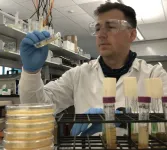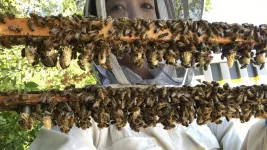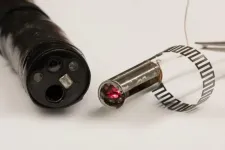(Press-News.org) Pulsed ultraviolet light can be an effective alternative to some of the antimicrobial technologies now used by the poultry industry to kill pathogens on eggshells, according to Penn State researchers, who simulated production conditions to test the technology.
Researcher Paul Patterson, professor of poultry science, College of Agricultural Sciences, suggests the technology has merit for commercial application in the egg industry.
"This study is unique because it scaled-up and applied components of standard egg processing to a conveyor and sanitizing eggs in a commercial setting," he said. "In the absence of water or other chemical sanitizers, this technology has the potential to achieve significant -- equal or greater -- microbial reductions than some currently available technologies."
Every year in the United States, an average of 287 eggs are consumed per person, and more than 14.1 billion eggs are set in hatchery incubators to produce chicks destined for the egg and meat bird industries. By reducing the microbial load on eggs, foodborne illness outbreaks associated with eggs and poultry meat can be reduced while chick health is maintained.
The egg industry currently uses sanitizers and detergents to decontaminate eggs and wash off any physical debris, while low-intensity ultraviolet light has been used as an additional antimicrobial step. However, pulsed ultraviolet light is more effective, explained lead researcher Josh Casser, doctoral candidate in animal science, because it delivers a higher intensity of ultraviolet light to the surface of the eggshell. That results in a greater microbial reduction in a shorter period of time than conventional ultraviolet light treatment.
In this study, the surfaces of shell eggs were inoculated with nonpathogenic bacteria strains used for research and were treated with pulsed ultraviolet light derived from a xenon flashlamp. Eggs were exposed on a modified egg-carrying conveyor that provided complete rotation of eggs under the flashlamp.
The novel conveyor devised for the experiment was instrumental in achieving acceptable decontamination, Casser noted, adding that the xenon flashlamps could be scaled up and customized for any commercial installation.
"As the egg rotates on its long axis along the way, the entire surface of the eggshell is exposed to the pulsed ultraviolet light energy, and the 27 seconds of exposure in our experiment resulted in an acceptable germicidal response," he said. "At three pulses per second, each egg is exposed to nearly 90 pulses, and each pulse has a duration of 360 microseconds -- an extremely short duration pulse."
The researchers, who recently published their results in Poultry Science, found that pulsed ultraviolet light treatment inactivated two different microbial strains, with greater energy resulting in a greater germicidal response.
The study also evaluated the effects of pulsed ultraviolet light treatment of hatching eggs on both embryo and chick growth. Using the same system, four batches of 125 fertile eggs were treated with the same and greater intensities of pulsed ultraviolet light. After processing, eggs were placed in a commercial incubator under normal incubation conditions.
There was no significant effect of the pulsed ultraviolet light treatment on percent fertility, hatchability or hatch. Also, there were no significant effects on post-hatch observations, including chick livability and average bird weight at hatch or at 42 days of age.
"Our research supports the application of pulsed ultraviolet light as an effective antimicrobial intervention for both table and hatching eggs," Cassar said. "If the egg industry embraces pulsed ultraviolet light technology and applies it in its processing operations, food safety would be improved because of the reduced pathogen presence on the surface of the eggs. And that matters because 9% of all foodborne illness in the U.S. is associated with eggs."
The technology is especially promising because it appears to have no negative consequences for the vital hatching-eggs component of the business, even at 10 times the UV-light intensity used in the table egg study, Patterson pointed out. Hatcheries produce the replacement stock for both the egg and broiler flocks of the poultry industry, including turkeys.
"Our research showed that there are no negative effects on hatching eggs and the embryos and chicks that are derived from those treated eggs," he said. "Using pulsed ultraviolet light before incubation in a hatchery setting would improve chick health, would avoid some of the financial constraints caused by poor chick quality resulting from chicks getting sick from early exposure to microbial pathogens, and potentially would improve the food safety of poultry meat."
INFORMATION:
Also involved in the research were Ed Mills, associate professor of meat science; Ali Demirci, professor of agricultural and biological engineering; and Lindsey Bright, undergraduate student in animal science and recipient of a College of Agricultural Sciences Undergraduate Research Award.
The U.S. Department of Agriculture's National Institute of Food and Agriculture partially supported this work. Hy-Line North America supplied the eggs used in this research, and Xenon Corp., of Wilmington, Massachusetts, provided technical assistance with the pulsed ultraviolet light technology.
Honey bee health has been on the decline for two decades, with U.S. and Canadian beekeepers now losing about 25 to 40% of their colonies annually. And queen bees are failing faster than they have in the past in their ability to reproduce. The reason has been a mystery, but researchers at North Carolina State University and the University of British Columbia are finding answers.
Their latest research, published Jan. 8 in the journal Communications Biology, offers clues about what's behind queen bee failure, finding that when sperm viability is low, the expression of a protein known to act against pathogens such as bacteria and viruses is high.
David Tarpy, a University Faculty Scholar and professor in NC State's Department ...
BOSTON -- Completing cancer screening tests, such as mammograms, can be challenging for low-income people, who may face such challenges as lack of transportation or inability to take time off work. A team at Massachusetts General Hospital (MGH) explored the possibility of addressing preventive care needs when patients are admitted to the hospital.
The pilot study, published in the Annals of Family Medicine, examined the feasibility of performing mammograms in women insured by Medicaid or both Medicaid and Medicare (dual-eligible patients) while they were hospitalized. "We designed the study to reach the patients who face significant barriers to completing their mammograms in the outpatient setting," says Andrew S. Hwang, MD, MPH, an internist at MGH and first author of ...
DES PLAINES, IL -- Among children who were not in an independently verified incident, evaluation for child abuse should be done by specialty consultation in children aged less than three-years old presenting with rib fractures and children aged less than 18-months presenting with humeral or femoral fractures. That is the conclusion of a study titled Identifying Maltreatment in Infants and Young Children Presenting with Fractures: Does Age Matter?, to be published in the January 2021 issue of Yersinia pestis (AEM), a journal of the Society for Academic Emergency Medicine (SAEM).
The lead author of the study is Ian ...
Since the dawn of the 21st century, there has been a rapid rise in the number of human immunodeficiency virus (HIV) infections in China, and today, the epidemic continues to grow. Several populations are victims of this virus, including injection drug users, sex workers, and men who have sex with men (MSM). In the various decades since HIV has gripped China, these groups and others have variously been at the forefront or background of national efforts to tackle the epidemic.
In the recent past, the prevalence of HIV has been high among the MSM population, particularly, MSM students. According to China CDC's national data on newly reported ...
(Boston) -- Minimally invasive surgeries in which surgeons gain access to internal tissues through natural orifices or small external excisions are common practice in medicine. They are performed for problems as diverse as delivering stents through catheters, treating abdominal complications, and performing transnasal operations at the skull base in patients with neurological conditions.
The ends of devices for such surgeries are highly flexible (or "articulated") to enable the visualization and specific manipulation of the surgical site in the target tissue. In the case of energy-delivering devices that allow surgeons to cut or dry (desiccate) tissues, and stop internal bleeds (coagulate) deep inside the body, a heat-generating energy source is ...
Earth's ability to absorb nearly a third of human-caused carbon emissions through plants could be halved within the next two decades at the current rate of warming, according to a new study in Science Advances by researchers at Northern Arizona University, the Woodwell Climate Research Center and the University of Waikato, New Zealand. Using more than two decades of data from measurement towers in every major biome across the globe, the team identified a critical temperature tipping point beyond which plants' ability to capture and store atmospheric carbon--a cumulative effect referred to as the "land carbon sink"--decreases as temperatures continue to rise.
The terrestrial biosphere--the activity of land plants and soil microbes--does much of Earth's "breathing," exchanging ...
Researchers from MBARI, the University of Hawai'i at Mānoa (UH Mānoa), and Woods Hole Oceanographic Institution, after years of development and testing, have successfully demonstrated that a fleet of autonomous robots can track and study a moving microbial community in an open-ocean eddy. The results of this research effort were recently published in Science Robotics.
Autonomous robotic fleets enable researchers to observe complex systems in ways that are otherwise impossible with purely ship-based or remote sensing techniques. In a time when the COVID-19 ...
Rising temperatures could trigger Earth's terrestrial ecosystems to transition from carbon sinks to carbon sources in the next 20 to 30 years, according to data from the world's largest continuous carbon monitoring network. The researchers suggest that up to half of land ecosystems could reach this tipping point - when plants begin to release carbon into the atmosphere faster than they sequester it - by 2100 under a business-as-usual emissions scenario. However, biomes that store the most carbon, including rainforests and Taiga forests, may lose more than 45% of their ...
A keen sense of smell is a powerful ability shared by many organisms. However, it has proven difficult to replicate by artificial means. Researchers combined biological and engineered elements to create what is known as a biohybrid component. Their volatile organic compound sensor can effectively detect odors in gaseous form. They hope to refine the concept for use in medical diagnosis and the detection of hazardous materials.
Electronic devices such as cameras, microphones and pressure sensors enable machines to sense and quantify their environments optically, acoustically and physically. Our sense of smell however, despite being one of nature's most primal senses, has proven very difficult ...
Scientists from the Pacific Quantum Center of Far Eastern Federal University (FEFU) figured out how the AFV3-109 protein with slipknot structure folds and unfolds depending on temperature. The protein is typical for the viruses of the oldest single-celled organisms that can survive in the extreme conditions of underwater volcanic sources - archaea. The research outcome appears in PLOS ONE.
Using numerical methods and applying quantum field theory that is unique for the study of proteins, the FEFU scientists have probed into the folding topology (scheme) ...






